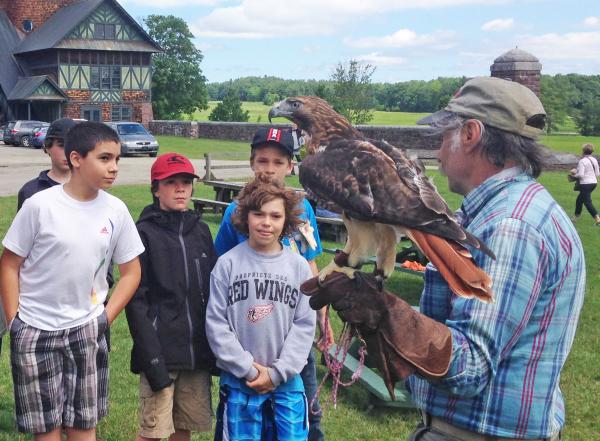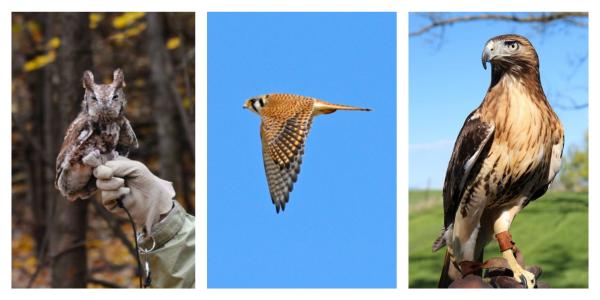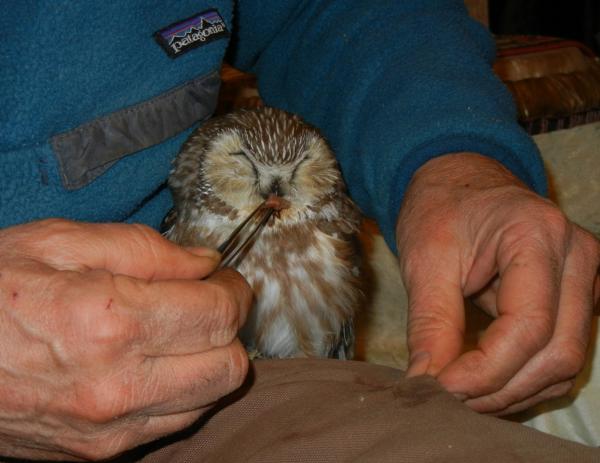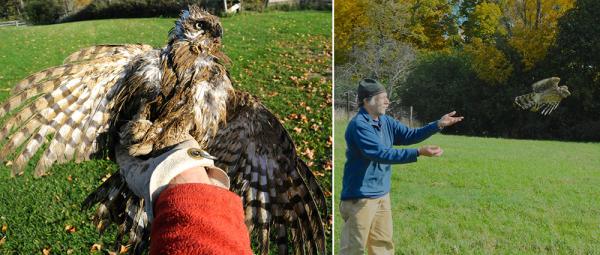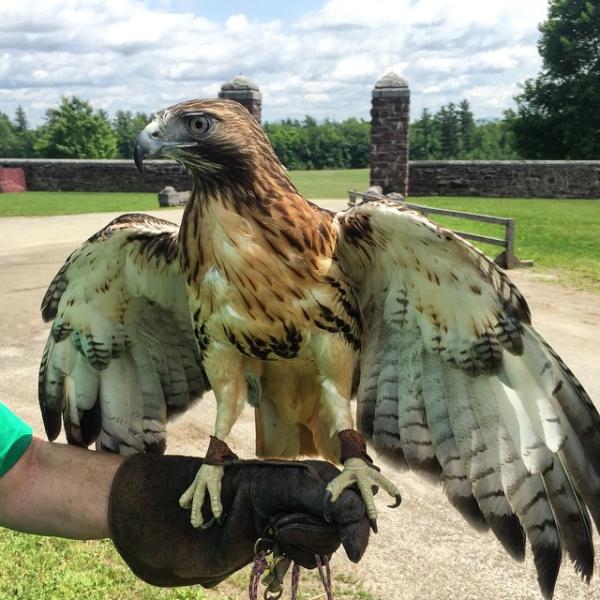such wonderful bird stories. i'm glad OFES is there to help injured birds heal and mostly return to the wild. so wonderful that shelburne farms offers a place for this wild healing.
Birds Take Flight - The work of OFES
“Ewww! That is so gross!”
“Wow. That’s the coolest thing I’ve ever seen!”
Crowded around a hawk on the arm of Craig Newman of Outreach for Earth Stewardship, 6th grade students from Montreal were in equal parts repelled and awed as they watched the hawk devour a dead rat that Craig casually drew from his pocket.
“She needs lunch, too,” shrugged Craig.
Craig and his feathered friend, a female red-tailed hawk named “Abbey,” were on lunch-time duty near the Farm Cart at Shelburne Farms. Abbey’s presence was keeping pesky gulls from swooping in to steal food from visitors, so she was making appearances in the Farm Barn courtyard all season. Craig, meanwhile, answered questions from the curious.
“Is she an eagle?”
“Why doesn’t she fly away?”
Craig is right at home with all the inquiries. After all, it’s OFES’s mission: to strengthen respect and understanding for wildlife through education. With its raptor ambassadors (birds of prey like eagles, hawks, falcons, or owls), OFES has pretty compelling messengers.
Now, on October 17th, OFES is celebrating its second annual Benefit Celebration at the Coach Barn called “Birds Take Flight.” There’s a lot to celebrate.
Back in 1989, Craig and OFES co-founder Eveleen Cecchini were both traveling from the Burlington area to do raptor rehabilitation work at the Vermont Institute for Natural Science in Queechee. But they tired of the long commute, and were eager to develop their own bird rehab facility. They set up shop as a nonprofit organization and not long after, began offering educational programs at Shelburne Farms.
In 1997, that relationship deepened when OFES moved its headquarters – and its collection of educational and recovering birds -- to the Farm. Old kennels were converted to aviaries and rehab facilities, and the educational collaboration was formalized. Since then, OFES owls and hawks have been working their magic at Farm campfires, special events, family programs, and summer camps.
“OFES allows us to offer many wildlife education programs that complement and enhance our own mission of educating for a sustainable future,” says Shelburne Farms Vice President Megan Camp. “And we offer them the facilities to do their important rehab work.”
In addition to Farm appearances, OFES offers programs to schools, camps, and scouts. Education is also conducted informally: through countless phone conversations with individuals who call with a bird they think is sick, hurt, or abandoned. “We take calls from Bennington to Newport, at all hours of the night and day,” Craig says.
Based on what he hears, Craig carefully assesses whether there’s need for intervention, while educating the person on the other end of the line. “Lots of times people see little birds bopping around the yard and think they’re in danger or hurt. But that’s what birds do when they fledge. It’s normal.”
Although birds can be hurt by wires, windows, fights, or house cats, car collisions are the overwhelming cause of injury. These are usually the birds that end up at OFES’s door.
OFES rehabs about 50 birds a year, primarily raptors, occasionally a crow or raven. The length of rehab depends on the injury. A bird with a concussion can recover in a couple of hours; a bird with a broken wing may take 6 months or more.
Time of year matters, too. OFES often over-winters migratory birds that are admitted in late autumn, because there’s simply not enough time to get them in condition for a long flight south.
Preparing birds for release can be tricky. Adult birds that haven’t been confined for very long just need to be in good flight condition. Orphaned birds, however, need to be tested for their ability to catch prey before they can be let go. “Orphaned birds are the most difficult to rehab,” Craig admits.
Some birds can never be returned to the wild due to permanent injuries. OFES has 12 such birds in its “permanent collection.” They are the stars of the educational show.
Like Abbey. Named after the environment activist and writer Edward Abbey, she was found eight years ago, at about a year old, starving on the ground with a broken wing. (It’s rare to be able to determine a bird’s age. But red-tailed hawks only develop the characteristic red tail at a year old, and Abbey’s tail wasn’t red when she was brought in, so Craig was able to peg her age with confidence.)
Abbey survived, but her wing never healed properly. “She can flap around and fly a little,” explains Craig, “but she can’t soar.” So she is now a raptor ambassador (and nemesis of gulls).
Like most of the OFES birds, Abbey has a diet of rodents, mostly mice and rats. Craig buys them frozen, then stores them in coolers until they’re ready to be thawed out for meals.
A regular team of 10-12 volunteers (Craig among them) share responsibilities for scheduled feedings, care, record keeping, and educational programing. Perhaps a dozen more volunteers can be called in when special needs arise. Craig is also grateful to a few veterinarians who donate time for surgeries and procedures, as well as materials like drugs or radiographs.
OFES has both federal and state permits that allow “special possession” of wild birds for educational purposes. The permits detail the number and species of birds allowed. “Right now we want to add a merlin to our permanent population,” Craig explains. “To do that we need to spell out how we’ll house the bird, define what programming we’ll do with it, and how many hours.” OFES also fills out yearly reports on all its activities. It’s kind of a drag, but Craig knows the reporting is important. “Otherwise, people would just keep the birds as pets,” he says.
And Abbey, for all her comfort in the public eye, is most certainly not a pet. It is precisely her wildness that makes her such a compelling ambassador for the natural world. “Encounters with our hawks and owls are very powerful,” Craig reflects, “especially for kids. I have had parents of previous campers tell me that their now college-aged kid remembers OFES ambassadors by name.”
Then he continues. “Their longevity, poise, and majesty leave a lasting impression and a caring connection to the wild.”
Shelburne Farms is proud to partner with OFES and its wild ambassadors. Come find out more at Birds in Flight on October 17th or follow OFES on Facebook.
NOTE: Federal regulations prevent OFES from displaying birds that are in rehab, so any visit to their facility is by appointment only. But there are lots of opportunities to see their education birds through programs at the Farm and elsewhere. Contact OFES.
Comments
Great to read about rehabbing in VT. I did wildlife rehab for 25 years, raptors as well as critters from bats to beavers to Great Blue Herons. Grueling work but with great satisfaction.
Hi. I realize that you are very busy but I was hoping that you would reply to the email I sent you a few weeks ago. I was wondering how the hawk that flew into my upstairs window(2 panes of glass) was doing. You picked him up at my home on Grove St in Burlington. I would like to know if he survived and if he did,how is he doing.
Thanks, Sydney Mahnke
I've forwarded your email to Craig Newman at Outreach for Earth Stewardship, which is a separate organization with offices and aviaries on our campus. He should be getting in touch soon. Sorry for the delay!
Hawk did survive and was released.
